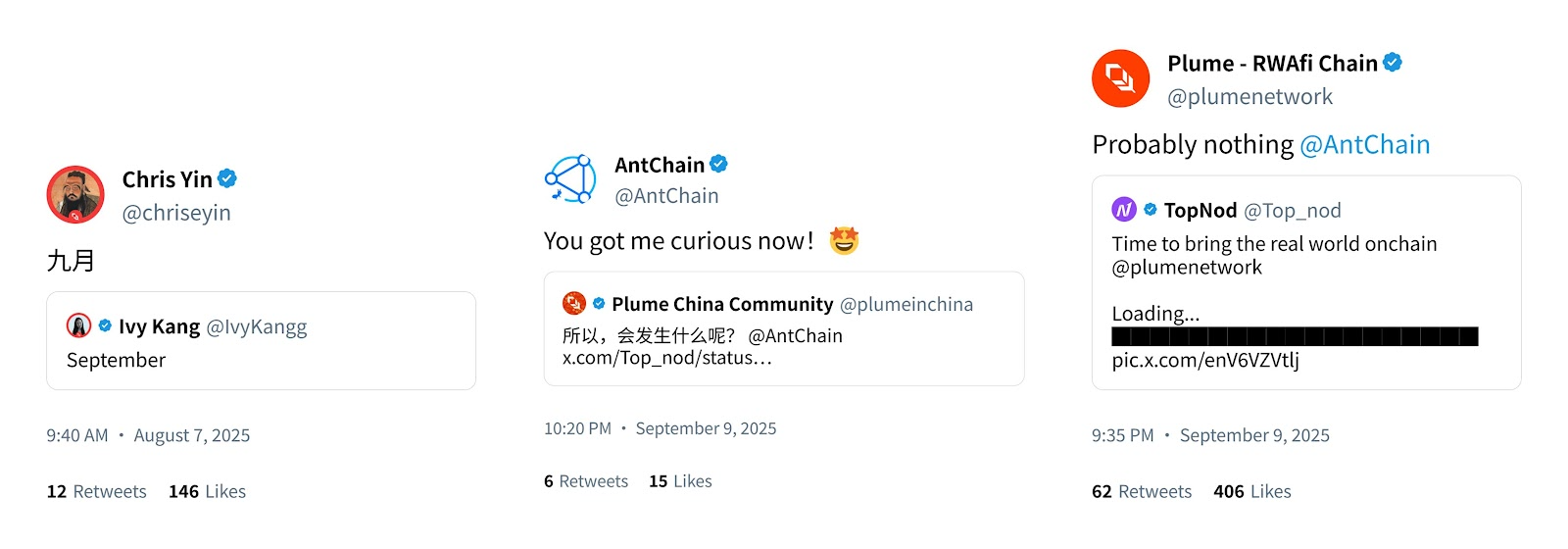If AntChain RWA Wants “Fresh Capital” in the Market, Can Plume Become a Compliant Liquidity Engine?
In early August, the Plume team stirred speculation with a “September” teaser, and CEO Chris Yin communicated in Chinese, leading the community to anticipate partnership developments in September. Recent public interactions between Plume and AntChain have further heightened these expectations.

Core Attributes and Strengths of Each Chain
AntChain
Positioning: AntChain is a leading permissioned consortium blockchain in China, serving government, enterprises, and industrial internet use cases.
Technical Highlights:
- Permissioned architecture and identity framework: Enterprise-grade certificate authorities, real-name mapping for organizations and individuals, and fine-grained permission controls.
- Auditable compliance: On-chain traceability, multi-node consensus, and integration with offline audit and risk management systems.
- High throughput and deterministic finality: Stable, business-grade reconciliation, settlement, and legal evidence collection capabilities.
- Privacy and data governance: Mature support for multi-party computation (MPC) and trusted execution environments (TEE).
Specialized applications: Supply chain finance, cross-border trade compliance, electronic certificates and on-chain evidence, industrial collaboration, and more—digitizing real-world assets and integrating them into regulatory frameworks.
Plume
Positioning: Plume is an EVM-compatible chain focused on Real-World Asset (RWA) integration, emphasizing RWA and DeFi composability and developer ecosystem expansion.
Technical Highlights:
- EVM/account system: Deep compatibility with Ethereum, enabling low-cost migration of contracts and developer tools.
- Compliance modules: Anti-Money Laundering (AML), whitelisting support, transferable restrictions, and modular verification logic.
- Native DeFi support: Modular composability for AMMs, lending, liquidity provision, yield distribution, and a range of market-making and derivative strategies.
- Global asset visibility: Assets gain exposure and secondary liquidity among global developers and market-making networks.
Specialized applications: Market-making, liquidity provision, stable vaults, leverage and recursive strategies, tokenized yield—enabling compliant assets to unlock liquidity and market access.
Practical Constraints in Integrating Permissioned and Public Chains
While integrating permissioned chains like AntChain with public chains such as Plume offers tremendous promise, it faces significant regulatory, technical, and operational challenges, which are especially pronounced in the evolving RWA ecosystem projected for 2025:
- Legal anchors: Onshore asset issuance and investor registries are tightly regulated (e.g., by mainland Chinese or Hong Kong authorities) and cannot be simply ported to a public chain without risking compliance breaches.
- Suitability and transfer restrictions: Only qualified investors (institutions or certified individuals) may hold or trade these assets; registries must be synchronized with the original systems in real time, excluding retail investors and increasing KYC requirements.
- Bridge trust model: Permissioned chains typically lack decentralized light-client verification, relying instead on operators, custodians, and regular audits—thus introducing centralization risks.
- Cashflow and redemption: Distributions such as coupons and rents, as well as maturity redemptions, require compliant cross-border flows and full-chain auditability, which requires complex technical integration.
Technical bridging alone is insufficient. Robust compliance, regulatory checks, and cross-chain operability are critical to leverage each chain’s advantages while mitigating risks—establishing a foundation for future collaboration models.
On August 26, GTJAI (Guotai Junan International) and Ant Group Digital Technology completed the inaugural structured product token cross-chain issuance from AntChain to Ethereum. The issuance featured fixed-income redeemable tokens and principal-protected products linked to U.S. Equity ETFs. This approach achieved T+0 settlement and transparent auditing, demonstrating a compliant liquidity mechanism similar to a custodial bridge. The approach serves as a successful blueprint for migrating AntChain RWA assets cross-chain to Plume. Additionally, Plume has previously supported the onboarding of the USD money market fund issued by CMB International under the Singapore-Hong Kong mutual recognition framework.
Three Feasible Collaboration Models
Model A: One-Way Issuance Gateway
Process:
- AntChain issues and holds assets in custody, verifying holders through KYC.
- The gateway institution locks the assets and mints mirrored tokens on Plume (ERC-20 and ERC-1155 tokens with compliance hooks).
- Only whitelisted wallets can transfer mirrored tokens.
- When redeemed, Plume burns the mirrored token, and the gateway unlocks the original asset rights on AntChain.
Features:
- Simple, transparent, and easily auditable.
- Best suited for standardized, short-duration assets with stable cash flows, such as rental income and receivables/factoring.
- Risk: Limited liquidity and dependence on gateway trust.
Model B: Bidirectional Custodial Bridge
Enhances Model A with:
- Proof of Reserves (PoR): Regular on-chain/off-chain reconciliation disclosures.
- Multisig/custodian arrangements: Decentralization of operational risk.
- Tiered shares: Priority and subordinate tranches to suit varying risk appetites.
This bolsters market confidence and enables diverse yield and maturity management products. Risk: Collusion among custodians can exacerbate systemic vulnerabilities.
Model C: ZK-KYC and Programmable Compliance
- Investors complete qualification verification on AntChain and receive an anonymous credential (ZK Proof).
- When trading on Plume, they prove eligibility without disclosing identity details.
- Achieves both compliance and privacy, supporting more open secondary markets and market-making networks.
Conclusion
The primary challenge with RWAs is not “writing the contract,” but “transposing the institutional framework on-chain.” AntChain anchors compliance and trust, while Plume catalyzes market access and asset composability. Combining a “trusted gateway + mirrored token” backbone with PoR, custody, and auditing tools enables AntChain RWAs to remain compliant while tapping into liquidity. Regulatory approval and technical or geopolitical risks may affect actual collaborations. We advise monitoring official updates—the bridge’s true value will be realized only when compliance and liquidity advance together.
Statement:
- This article is reprinted from [TechFlow], with copyright retained by the original author [Sanqing]. For any issues regarding reprints, please contact the Gate Learn team, which will process requests as appropriate.
- Disclaimer: The views and opinions in this article are those of the author and do not constitute investment advice.
- Other language versions of this article have been translated by the Gate Learn team. Do not copy, disseminate, or plagiarize translated content without citing Gate.
Related Articles

Reshaping Web3 Community Reward Models with RWA Yields

ONDO, a Project Favored by BlackRock

Real World Assets - All assets will move on-chain

What Are Crypto Narratives? Top Narratives for 2025 (UPDATED)

What is Plume Network
